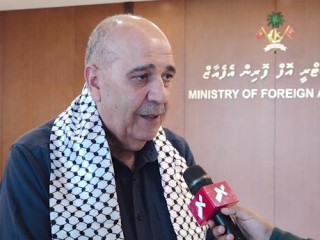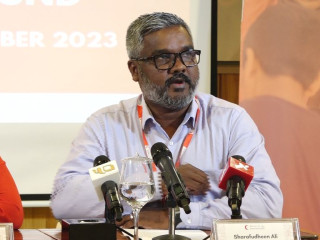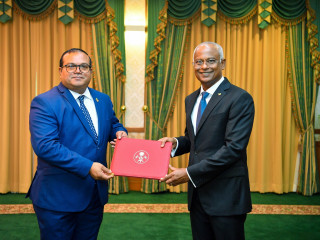President Abdulla Yameen has on Thursday night told supporters at a rally that the government will soon implement a ‘permanent solution', as his excellency described it, to the capital’s waste management issues.
At a rally held to officially announce the ruling Progressive Party of Maldives (PPM)’s candidates to contest in the upcoming local council elections, President Yameen said his administration is working to implement better incineration methods at the country’s main landfill, municipal island Thilafushi, just seven kilometers from the capital.
“We have found a permanent solution to our mounting waste problem” the President said.
President Yameen had also said that waste management is a priority to his government, but one that has not seen much progress yet. He had not specified what the potentially sweeping method of incineration would be, or when it would be implemented.
He then proceeded to criticize the handing over of managing solid waste generated in Malé City to India’s Tatva Global – an agreement nullified in 2015 on the grounds that Tatva had not made any progress three years into the contract.
“Why should we trust a foreign company to clean up our nation? Why should we depend on people who have no stake in our future” the President said.
The Waste Management Project (WAMCO) took over the project and had begun projects to build better infrastructure for waste discarding, and to utilize the ‘Industrial Village’ for storing.
In 2016, the government announced the Industrial Village, a USD 10 million project to reclaim four hectares of land off of Malé’s southwestern edge to build parking spaces, fuel stations, and waste management sections.
The status at Thilafushi
To put it plainly, Malé’s waste management issue is that it produces more than it can discard, and in too diverse streams. There is also a lack of access to proper transport and waste-energy facilities.
The Social Assessment and Management Framework released in November 2014 by the Ministry of Tourism and Energy reported that while over 300,000 metric tons of waste is discarded at the 'apocalyptic' Thilafushi every year, 51 percent comes from urban areas, 28 percent from island communities, and 21 percent from tourism – island resorts and safaris. The report further said that 70 percent of waste from the outer lying islands are recyclable, with the rest being classified as ‘residuals’.
The figures for island waste is in line with 2004 report by Julie Camerlynck from the Utrecht University, Netherlands, where she states that most waste from islands are solid biomass or agro waste.
An assessment of the Maldivian tourism sector’s resilience towards climate change by the Tourism Adaption Project and the UNDP in 2015 stated that most island resorts – with safaris having less encouraged practices – discard waste in ‘seeming’ compliance with MoTAC (the Malaysian Ministry of Tourism and Culture)’s guidelines.
The report further said Thilafushi has 20 hectares of disposal capacity left and would last 25 years if better practices are put in place. The Ministry’s report in 2014 further stated that an estimated 312,075 metric tons of solid waste is discarded at Thilafushi every year, and irresponsible loading and offloading results in waste ‘ending up in the sea’.
Further, while most of the waste in the country is destined for the Thilafushi landfill, there is considerable difficulty in transporting it there. Though there are over 130 Island Waste Management Centers operational across the nation, with Centers registered under the Ari Atoll Solid Waste Management project having access to sanitary landfills and a waste-energy facility in Raa Atoll, a system to collect waste from the centers does not exist.
Thilafushi is made up entirely of waste materials, and has been the nation’s primary landfill since 1991. Waste is still used to reclaim more, and the manner in which waste is accumulated for transport generally results in elements that are potentially hazardous to marine life sinking into the sea, seeping into reefs, and washing up on shores.
Prospects
Maldives’ official policy on incinerating solid waste advocates methods that are not detrimental to the environment, however according to the 2015 report; waste is currently incinerated in large open fires.
Combustion is efficient in that it has the capacity to destroy large amounts at a time, is cheaper, and provides better opportunity for waste-energy utilization. However, it emits a considerable amount of harmful pollutants and creates ash that pose health risks and the threat of destruction to plantation. Other methods such as pyrolysis and gasification are less harmful, but more expensive and less efficient.
The Tourism Adaption Project in 2014 recommended prevention and recycling to be the best options for Maldives currently, and insisted that more landfills are the worst.
Therefore, while more modern incineration methods are definitely commendable, it can be surmised that the scope of the country’s waste management problem stretches over multiple factors of state administration and public attitude.





